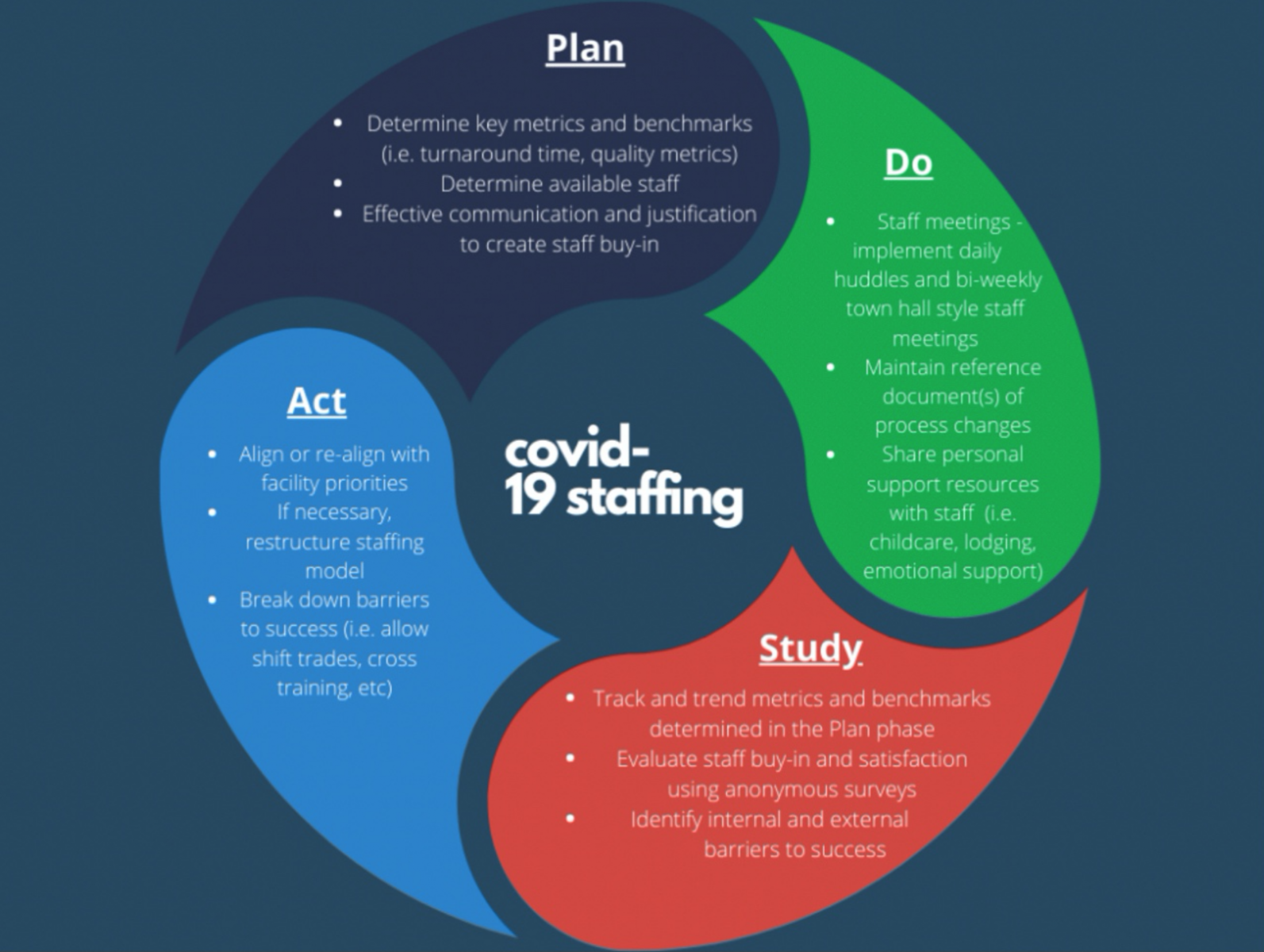Article
Fostering Rapid Innovation During a Time of Crisis
Author(s):
Promoting an environment that allows for rapid problem-solving and execution under high stress is essential to face problems that are poorly understood and yet require rapid change.
Innovation leadership is imperative for organizational success.1 An innovation leader is able to foster employee creativity, voice, and knowledge to transform ideas into new products or services that can be used.1
Innovation is defined as a new idea, method, device, or the introduction of something new.2 Whether or not a crisis is predictable, leaders have to adapt to the emerging threat to appropriately and quickly prepare and respond. As such, the innovation process must be accelerated.
Being able to harness creativity, the heart of innovation, in the organization and workforce becomes particularly important in responding to a crisis. Promoting an environment that allows for rapid problem-solving and execution under high stress is essential to face problems that are poorly understood and yet require rapid change.3 Organizations have to be nimble and adapt in creative ways.
Supporting an environment that promotes ideas and fosters creativity requires a common language to help people communicate efficiently.4 The application of the Institute for Healthcare Improvement’s methodology by using its Model for Improvement framework can be one such common language.
Employing the 4-stage Plan-Do-Study-Act (PDSA) cycle from the rapid cycle improvement strategy is an effective model to foster innovation (FIGURE).5 We have used examples and lessons learned from the coronavirus disease 2019 (COVID-19) pandemic response to display how PDSA can be used to foster rapid innovation.

Figure. Plan-Do-Study-Act cycle used to foster innovation
Plan
During a time of crisis, the planning phase of the PDSA cycle is often driven by circumstances rather than a targeted problem being identified by a formal planning process. A crisis may also limit the type of intervention that can be made.
Given these constraints, the planning process is often more reactive than proactive. Generally, though, problems fall under 1 of 3 categories: clinical-, operational-, or workforce-related. Depending on the category, the targeted intervention may differ.
Clinical changes may involve protocol changes or use restrictions that may require approval from external departments. Operational changes, such as workflow or process changes, may be able to be implemented internally.
Workforce interventions may involve a combination of internal and external resources. Regardless of the origin of the targeted problem or type of intervention, there must be measurable data identified that can assess the impact of the intervention.
Staff engagement is another element of the usual planning phase that is affected during a time of crisis. Typically, effective communication and justification are essential for staff to “buy-in” to a change. During a crisis, however, staff may be eagerly awaiting a change in response to the circumstance.
Because the staff is engaged, it is an excellent time to solicit feedback and suggestions. Unusual circumstances may also empower staff to suggest unusual solutions or changes.
In this way, it could be argued that change management during a time of crisis may be somewhat easier than usual given this engaged staff. Although change management is affected by a crisis, it is important to remember that the intent of the intervention is the same, producing a positive or improved result as measured by a key metric.
For example, say the COVID-19 pandemic has caused an operational issue. Available staff has dropped by 40% due to sickness and operational functioning is affected. In this example, a potential change is needed in reaction to the circumstance.
Whatever the intervention is—reallocating staff to cover essential activities, for example—must have some measurable metric. Perhaps the key metric is turnaround time of orders or prescriptions.
If the normal turnaround time is 40 minutes, this benchmark can be used as a reference point to see whether the crisis-driven intervention is effective. If it is, maintain the change and if it’s not, implement a new intervention and start the PDSA cycle again.
Do
After developing a plan, the next key step is communication. If your department does not already hold daily huddles, now is the time to start them. Huddles are brief stand-up in-person or virtual meetings, including all staff, and are held at the same time each day. These meetings summarize operational plans for the day and should be concise while allowing for 2-way communication.
Staff input and engagement is key to refining existing processes and knowing when to trigger a new rapid innovation cycle. Additionally, holding a weekly or bimonthly town hall style meeting allows for an opportunity to take a step back from daily operations and share broader updates and future plans. For example, a daily huddle may share staffing updates for the next 24 hours, whereas a town hall may provide insights for staffing plans in the coming weeks or months.
Whether it be a clinical, operational, or workforce process change, it is important to understand the emotional and physical strain that accompanies these changes. Keep a clear, up-to-date, documented plan in a well-known place, such as a department website, as an aid for staff in navigating through changed processes.
Be sure to highlight available resources such as transportation, lodging, childcare or personal services, and emotional support services. Rounding with staff plays an important role in helping to understand individual and collective group needs and informing leaders of additional actions to consider.
Study
A vital step in making any change in your practice is tracking metrics related to the new process. These metrics should be developed and vetted in the planning stages of the change to assure they accurately represent the change being implemented.
Ideally, these metrics should be readily available to staff to increase transparency of the new process. Dashboards or other central locations for these data make it easy to access and provide a resource for all employees involved with the process. Metrics may vary depending on whether the project involves clinical or operational workflow.
For example, a clinical change may require the measurement of interventions made by the pharmacy team and collect data on the total number of interventions. Data that can be extracted from the electronic health record (EHR) and does not require manual tracking is preferred for ease of capture.
Consider the best type of analysis for your data, which is dependent on the type of data you collect (eg, nominal, continuous). If you are making an operational change that has pre- and post-data, consider how you will compare these data and whether it will require analysis beyond descriptive statistics.
It is important to set up periodic meetings for these metrics to be reviewed by the key stakeholders in the project to compare actual results with the initial predictions made by the team. This allows for scheduled decision points so the group can make any necessary adjustments to improve the success of the project.
Most projects will meet barriers that were not expected during initiation. During this portion of the project, it is important to determine which steps need to be taken to continue moving forward. Sharing these lessons broadly will help others outside of the immediate project team understand how these changes were implemented.
Act
The actions taken within the PDSA cycle are key to determine what modifications are necessary to optimize the operational, clinical, and workforce effectiveness and to plan for the next phases or implementations of changes needed for the department. Upon studying the results from the previous step, some questions to ask include:
- Did the team meet the goal set by the department and/or health system as it relates to clinical, operational, and workforce? What are the priorities of the health system and do our goals and/or changes implemented align accordingly?
- What are some external and internal factors inhibiting the success within operations and are those factors tied to clinical and/or workforce demands?
- As it relates to critical times, what are the essential clinical and operational activities needed to be accomplished to ensure patients are being treated appropriately and what are some activities that need to be addressed at a later date?
- Is the department maximizing the existing labor resources? Should the leadership team restructure the workflow and/or help teams prioritize patient care demands (eg, centralizing services vs decentralizing services vs combination; clinical specialists assisting with order verification, etc)?
- Are the changes implemented allowing teams to provide safe and quality patient care while maintaining the safety and integrity of employees?
These example questions can help aid in needed dialogue among pharmacy leaders to determine whether the original plan that was implemented requires adjustments for future success. In critical times, the department may revisit the PDSA cycle on a weekly basis to ensure the patient care that is provided is changing with new developments in treatment protocols, epidemiology of diseases, and financial feasibility of the health system. Leaders will need to be adaptable and have transparent communication in order to take the best course of action for patient care services.
Conclusion
In a crisis, extraordinary demands are placed on leaders to problem solve and execute quickly. Oftentimes in a high-stress and chaotic environment, it is essential to foster rapid innovation to address known and unknown issues. Thus, setting up an infrastructure to facilitate the implementation of innovative ideas is vital.
Rapid innovation may be uncomfortable for many people but using a model, such as the PDSA cycle, facilitates conversation, feedback, and collaboration among employees across all levels in the organization. Being able to see the progress, staff are empowered to voice their feedback and ideas that can trigger a new rapid innovation cycle. Continual fostering of rapid innovation across the organization is critical during a time of crisis.
References
- Kremer H., Villamer I., Aguinis H. Innovation leadership: Best-practice recommendations for promoting employee creativity, voice, and knowledge sharing. Bus Horiz. 2019;62:65-74.
- Merriam-Webster’s Online Dictionary. Innovation. https://www.merriam-webster.com/dictionary/innovation (accessed 2020 May 1).
- D’ Auria G.,Smet AD. Leadership in a crisis: Responding to the coronavirus outbreak and future challenges. McKinsey & Company. 2020.
- Basadur, M. Leading others to think innovatively together: Creative leadership. Leadersh Q. 2014;15(1): 103—121.
- Institute for Healthcare Improvement. Science of Improvement. http://www.ihi.org/about/Pages/ScienceofImprovement.aspx (accessed 2020 May 1).
About the Authors
Tina Do, PharmD, MS, BCPS
Manager, Ambulatory Clinical Pharmacy Services
Yale New Haven Hospital
New Haven, CT
James Blackmer, PharmD, MPA, MS
Operations Manager, Adult Inpatient Pharmacy
Johns Hopkins Hospital
Baltimore, MD
Joshua Blackwell, PharmD, MS
Clinical Pharmacy Manager
Johns Hopkins Home Care Group
Baltimore, MD
Rachel Root, PharmD, MS, BCPS
Pharmacy Manager and PGY1 Residency Program Director
Abbott Northwestern Hospital
Minneapolis, MN
Steven Silverstein, PharmD, BCPS
Pharmacy Health System Director
Mercy Hospital and Medical Center
Chicago, IL
Melanie Smith, PharmD, BCPS
Clinical Pharmacy Manager and PGY1 Residency Program Director
Research Medical Center
Kansas City, MO
Author disclosure statement: The authors have declared no potential conflicts of interests.
Newsletter
Stay informed on drug updates, treatment guidelines, and pharmacy practice trends—subscribe to Pharmacy Times for weekly clinical insights.






